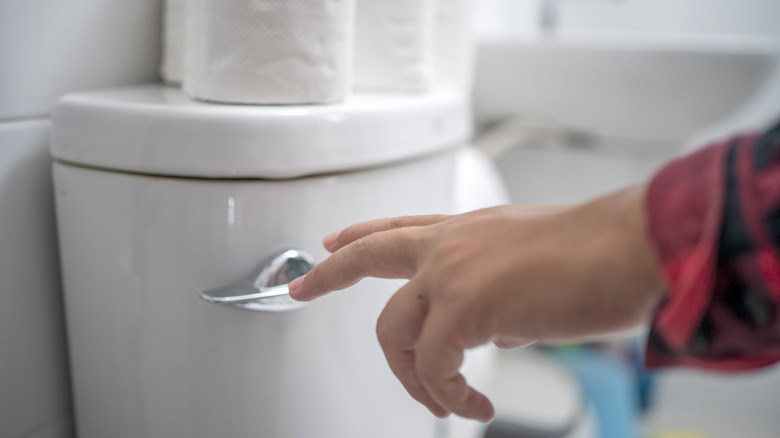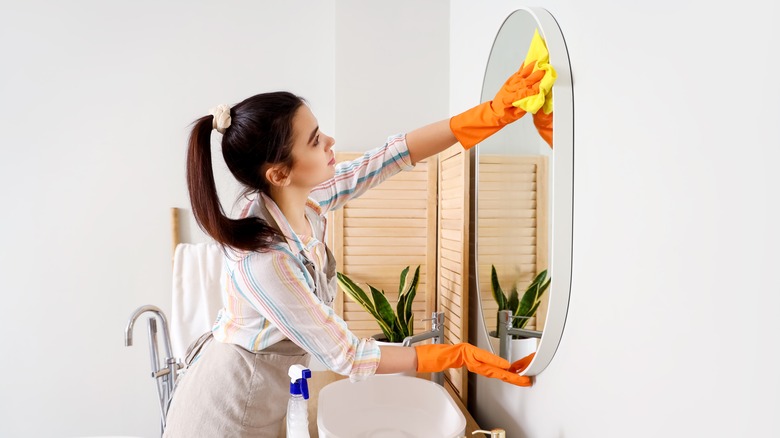10 Things In Your Bathroom You Should Be Cleaning Daily Or Weekly
Cleaning the bathroom may be the last thing you want to do, but it's necessary to stop the spread of germs and bacteria. A world of contagious and harmful illnesses can lurk in your bathroom, including E.coli, gastrointestinal viruses, athletes foot, and other skin conditions. If you regularly neglect your bathroom cleaning routine, you could put yourself and your family members at risk, which is why it's important to clean surfaces like the countertops, toilet seats, and fixtures.
While the bathroom isn't the dirtiest place in your house, it's certainly one of the biggest harborers of germs, especially if you don't clean fixtures, like the toilet and shower, regularly. Yet, many people will tell you that they clean the bathroom only once a month or less! When you finally do clean a bathroom, it can be a more time-consuming process because it's been so long, which is why daily and weekly cleaning of these things is recommended.
Wipe down your toilet handle to disinfect airborne germs
If you share your bathroom, you should definitely wipe toilet handles daily. Toilet flushing disperses particles into the air, including viruses and germs. According to the University of Colorado Boulder, droplets spread 6.6 feet per second, reaching 4.9 feet above the toilet in eight seconds. Exposure to droplets on your toilet handle could make you sick, especially as scientists know salmonella can live for hours on a surface with some strains able to survive four days if the surface has heavy contamination.
Empty and wipe down bathroom trash cans weekly
You should empty the trash at least once weekly to avoid an overflowing can. Cleaning the trash bin can also reduce odor buildup, as bathroom trash can get pretty funky, especially if you have kids. You'll also cut down on the chances of your pets digging into the trash for unsavory things or chewing up strands of stray dental floss. Keep an eye on your trash and its contents, adjusting to emptying it every couple days as needed, such as during cold and flu season. After removing the trash, give the can a quick wipe with an antibacterial disinfectant.
Dry your shower daily after each use
By drying your shower after every use, you reduce the chance of hard water spots and buildup. Use a squeegee to reduce moisture, which could lead to mildew on tiles or glass, and dry it with a clean microfiber towel. Another thing to keep in mind is the bathroom's humidity, which is why experts advise you run your bathroom fan during a shower or for 20 minutes after, as excessive moisture on your walls can encourage mold growth. Taking some time daily to wipe your shower also makes it easier to clean in the future.
Wipe your mirror weekly of fingerprints and water spots
Airborne particles from your toilet flushing, fingerprints, water spots, and even toothpaste may mar the surface of your mirror. Take the time to wipe away anything that accumulates on the mirror each week. You don't have to perform a deep cleaning, unless it's particularly grimy, but make sure everything is thoroughly wiped with a clean microfiber cloth, which won't leave lint like other cloths. You can also mix equal parts of distilled white vinegar and water in a spray bottle, shaking to combine, then spray on the mirror for any hard-to-remove spots.
Wipe water off your floor daily to avoid slipping
Try to wipe up any water off the floor after every bath or shower. Not only will you prevent the risk of slipping, but you'll also pick up any stray hairs that may accumulate and can get stuck to the floor, so they don't end up on your feet. Wipe all along the floor, including behind the toilet, to make sure you get all of the water. Make sure to also dry off the back of your bathroom mat.
Scrub the bathroom door handle and hardware
Handles and hardware are some of the most high-touch areas in the bathroom. Think about how you enter your bathroom, open its cabinets, close the door. Now think about how the toilet flush might spew bacteria in their direction, germs you could possibly spread throughout the rest of your bathroom or house. First, wipe hair and dust off the handles with a paper towel. For the door handles, you can use water mixed with dish detergent, then gently wipe with a microfiber cloth, then rinse. Do the same with the cabinet hardware, avoiding abrasive chemicals which may remove the finish.
When the lights come on, so do the germs
Each time you switch on your bathroom light, you expose your hands to bacteria. Yes, you should wash your hands each time you're done with the bathroom, but what about when you enter the bathroom to grab a towel or retrieve something? Light switches are likely one of the parts of your home you aren't cleaning enough. However, experts estimate as many as 217 bacteria per square inch make their home on your light switches. Buff with a clean microfiber cloth, then follow up gently with an antibacterial wipe.
Your bath mat equals germs galore
Your bath mat might look clean, but it can hold a variety of bacteria, in fact, it's widely-considered one of the dirtiest things in your bathroom. So, if you frequently use the mat, wash it weekly. Shake it free of debris outside, then use stain remover, if needed. After you treat the stains, toss in the washing machine and wash according to the tag, or you can soak in the tub, then hand wash with water and a mild detergent. Let it air dry completely before setting it back on the floor.
Wash away germs from your sink and faucet
Brush, rinse, spit. Can you imagine how many germs gather in your sink? According to a 2011 study by NSF International, faucet handles were the sixth dirtiest item in the bathroom. What's more, of the 81% of homes with coliform, 9% of households featured coliform on faucets. Coliform bacteria is associated with waste, so that should tell you how much you need to clean your sink and faucet. Spray the sink and faucet with your favorite antibacterial cleaner, then let it sit for at least 30 seconds to sanitize and 10 minutes to disinfect, then wipe.
Scrub the funk away from the toilet seat and bowl
It may not be as disease-ridden as other items on this list, but the toilet swims with bacteria, with over 200,000 units on the toilet seat alone. Hit the toilet seat with an antibacterial wipe, letting it stay wet for 10 minutes. For the bowl, use your preferred toilet bowl cleaner, letting it sit for a few minutes. After it sits for a bit, grab your trusty toilet brush and work your way around the bowl and rim, removing all of the gunk under there, then flush away.










